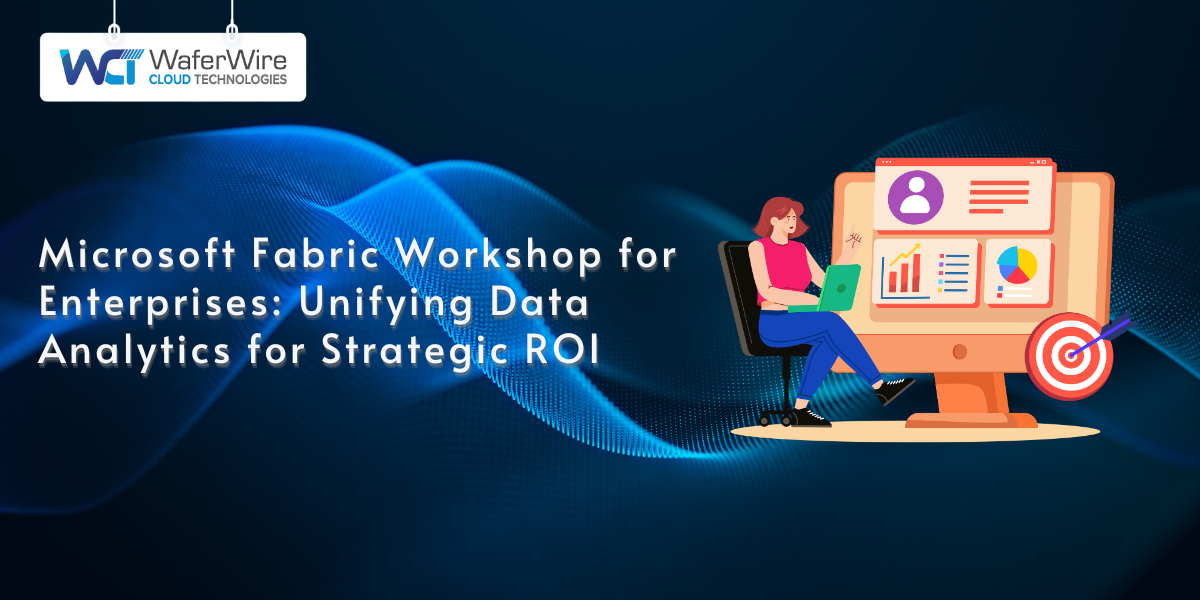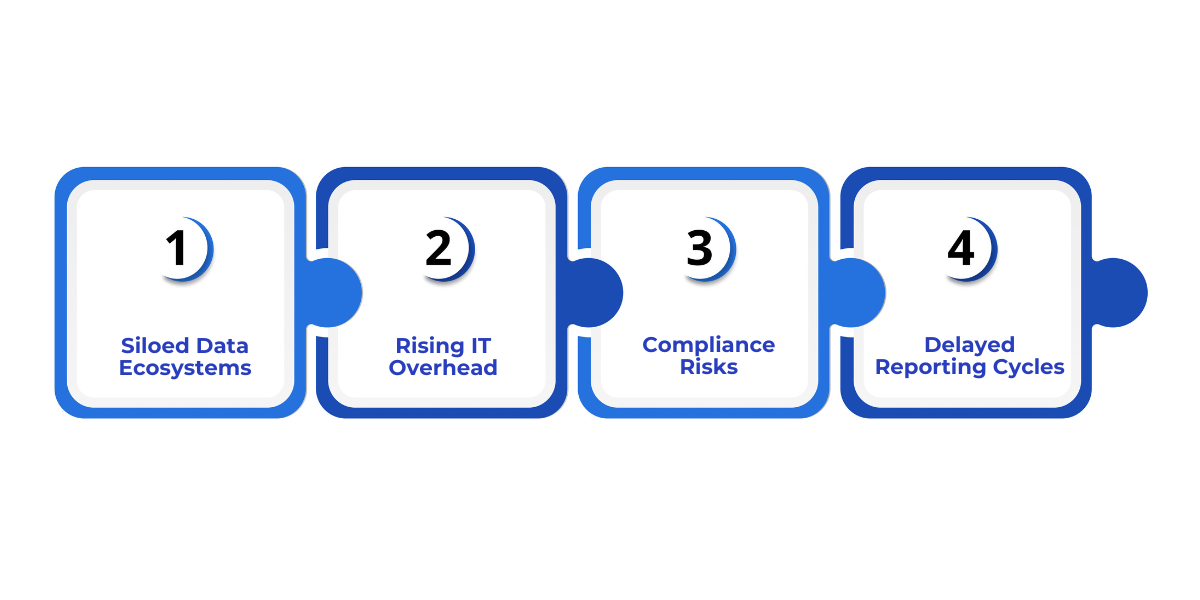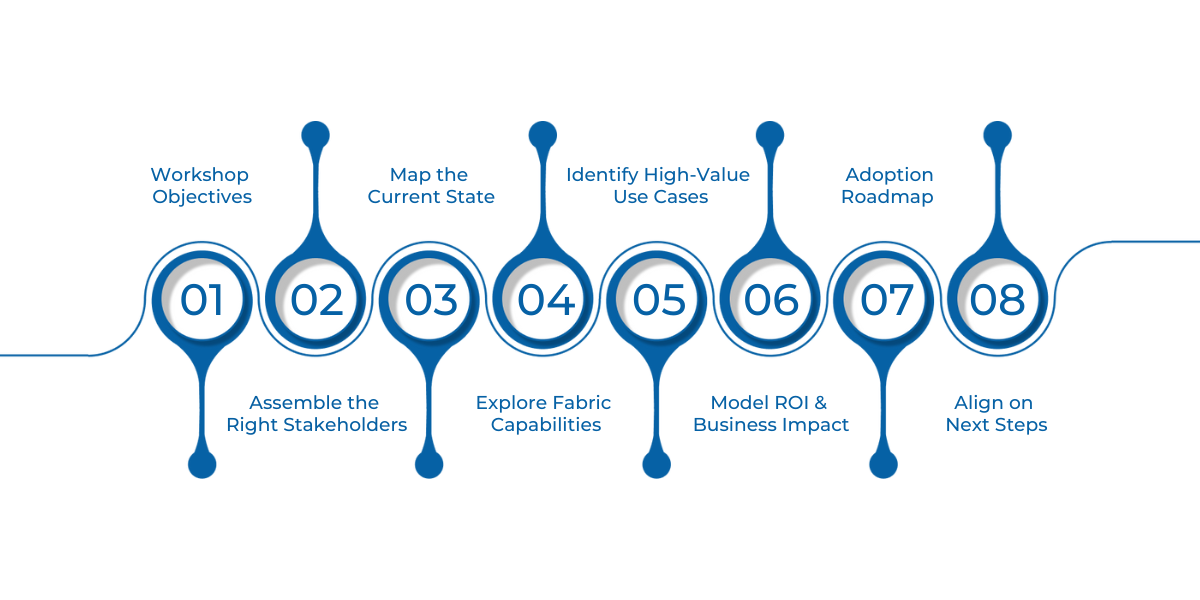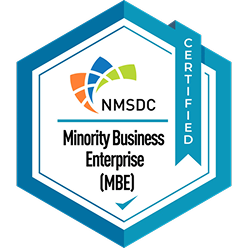

A well-structured Microsoft Fabric workshop for enterprises gives C-level leaders a clear path to unlock that potential. It helps translate technical capabilities into business value, providing faster time to insight, cost consolidation, built-in governance, and alignment with growth objectives.
In the following sections, we’ll explore how to design such a workshop, what outcomes you can expect, and how enterprises can utilize Fabric to transform data from an operational burden into a strategic asset.
In short: how to turn your company’s data fabric into a real engine for growth.
A Fabric workshop for enterprises is not a product demo; it’s a structured, strategic session designed to help organizations evaluate how Microsoft Fabric can transform their data and analytics landscape. These workshops are typically run by Microsoft-certified partners or Fabric specialists and are tailored to the needs of enterprise leadership teams.
Instead of diving straight into features, the workshop begins with an assessment of your current state: where your data resides today, the challenges your teams face, and which gaps are slowing down decision-making. From there, facilitators map Fabric’s capabilities against your business priorities—whether that’s faster forecasting for finance, full-funnel analytics for marketing and sales, or real-time operational intelligence for supply chains.
For C-level decision-makers, this approach answers a critical question: How does this technology translate into measurable business value? By the end of the workshop, enterprises walk away with:
In short, a Fabric workshop provides the bridge between technology and outcomes—helping enterprises move from curiosity about Fabric to a confident, board-ready business case.
Enterprises today don’t struggle with a lack of tools—they struggle with too many. Data is often spread across multiple platforms, each with its own governance, licensing, and integration challenges. For executives, this translates into slower decision-making, higher costs, and inconsistent insights across departments.

A fabric workshop for enterprises offers a structured approach to addressing these pain points before investing heavily in a new platform. Instead of approaching Microsoft Fabric as just another IT tool, the workshop reframes it as a business strategy enabler:
Workshops are not about technology for the sake of technology. They’re about building confidence at the leadership level—showing how a unified analytics platform can directly contribute to growth, efficiency, and competitive advantage.

A fabric workshop for enterprises is designed to do more than explain Microsoft Fabric—it’s about helping leadership teams connect technology to strategy. While each workshop is tailored to an organization’s needs, most follow a structure built around five critical elements:
The workshop begins by examining your existing analytics landscape. This includes reviewing where your data resides, which platforms you use, and the pain points your teams encounter. The goal is to establish a baseline, allowing leaders to identify inefficiencies and redundancies.
Facilitators work with executives to identify high-value business scenarios that Fabric can support. For example:
These scenarios are then ranked by impact and feasibility, creating a clear focus for adoption.
Rather than a “big bang” rollout, enterprises are guided to plan phased adoption. A roadmap highlights quick wins (like automating manual reports) alongside longer-term goals (like integrating AI-driven analytics). This ensures value is demonstrated early while keeping the bigger transformation on track.
Finally, workshops address the human element. They outline how training, governance, and cultural shifts will enable wider adoption across departments. This ensures that Fabric doesn’t remain an IT project—it becomes an enterprise-wide capability embraced by all business units.

Running a fabric workshop for enterprises requires more than just showcasing Microsoft Fabric’s features. To deliver value for decision-makers, the workshop must be structured, outcome-driven, and tailored to the organization’s unique challenges. Here’s a proven approach:
Begin by aligning with the executive team on what the workshop aims to accomplish. Common goals include:
A successful workshop involves both technical and business leaders:
This ensures discussions balance vision with feasibility.
Document existing tools, data silos, reporting processes, and pain points. This step provides a baseline to evaluate how Fabric can simplify and unify workflows. It also reveals hidden costs—such as manual reporting time or redundant licensing—that often strengthen the ROI case.
Facilitators walk through the key components of Microsoft Fabric, including OneLake, Power BI integration, real-time analytics, and AI copilots. Instead of a feature dump, the focus is on mapping each capability to business outcomes. Example: showing CMOs how Fabric unifies campaign data for real-time ROI tracking.
Through collaborative discussion, the team selects 3–5 priority use cases where Fabric delivers immediate impact. For example:
Using benchmarks and case studies, facilitators help quantify the financial upside of Fabric adoption. This includes cost reductions from tool consolidation, productivity gains across data teams, and new revenue opportunities from faster insights.
The workshop ends with a phased roadmap: quick wins to prove value early, medium-term rollouts for broader adoption, and long-term plans for scaling Fabric enterprise-wide.
Clear follow-ups are essential. This may include a pilot project, executive presentations, or training sessions to build momentum. The outcome is a shared commitment across leadership to move forward with confidence.

If your organization is considering Microsoft Fabric, the best place to start is with a fabric workshop for enterprises. These workshops are designed to help leaders transition from curiosity to clarity, turning a complex technology landscape into a strategic roadmap.
1. Identify Your Pain Points
Begin by listing the challenges slowing down decision-making today—delayed reporting, siloed systems, or rising analytics costs. These will shape the focus areas of your workshop.
2. Engage with the Right Partner
Microsoft and its certified partners regularly run Fabric workshops tailored for enterprise clients. Look for providers with experience in your industry and a track record of delivering business-focused sessions, not just technical demos.
3. Prepare Stakeholders
Invite leaders from both business and IT. CXOs, CMOs, CROs, and CFOs should all have a seat at the table to ensure alignment between strategy and execution.
4. Define Success Criteria
Decide what success looks like before the workshop begins. This could be a faster forecasting cycle, reduced IT overhead, or clearer visibility into the customer journey.
5. Commit to Next Steps
The true value of a workshop lies in its follow-through. Use the roadmap created in the session to pilot a high-value use case, track ROI, and build momentum for broader adoption.
With 70% of Fortune 500 companies already adopting Microsoft Fabric, the competitive advantage goes to those who turn insights into action faster. A fabric workshop for enterprises provides your leadership team with the clarity, confidence, and strategy to initiate that journey—without unnecessary risk or wasted investment.
Running a fabric workshop for enterprises is most effective with the right partner. WaferWire Cloud Technologies brings the expertise to make these sessions impactful by:
With experience across various industries and a focus on outcome-driven partnerships, WaferWire can help enterprises confidently transition from workshop insights to measurable results.
Ready to unlock the full potential of Microsoft Fabric? Connect with WaferWire today and schedule your enterprise workshop.
1. How long does a fabric workshop for enterprises typically last?
Most workshops run between half a day to two days, depending on the size of the organization and the number of stakeholders involved. Shorter sessions are used for initial awareness, while multi-day workshops allow for in-depth exploration of use cases, ROI modeling, and roadmap creation.
2. Who should attend a Fabric workshop?
A mix of executive decision-makers (CXOs, CMOs, CROs, CFOs) and technical leaders (CIOs, data architects, analytics managers) should participate in this discussion. This ensures the workshop balances strategic goals with technical feasibility, resulting in a roadmap that has buy-in from all parties.
3. Is a Fabric workshop purely technical?
No. While Microsoft Fabric is a technical platform, workshops are focused on business outcomes first. Technical demonstrations are included, but always in the context of ROI, competitive advantage, and operational efficiency.
4. How much preparation is needed before a workshop?
Minimal preparation is required. Enterprises benefit from sharing current pain points, existing analytics tools, and strategic priorities with the facilitators in advance. This ensures the workshop agenda is customized to your needs.
5. Can smaller enterprises benefit from these workshops, or are they only for large organizations?
Although designed with large enterprises in mind, mid-sized organizations can also gain significant value. Workshops can scale in scope, focusing on fewer use cases or smaller-scale ROI modeling, making them relevant for companies at different stages of analytics maturity.

